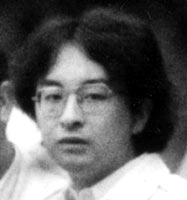
August 21, 1962 – June 17, 2008), also known as The Otaku Murderer, The Little Girl Murderer, and Dracula.
Background
Miyazaki's premature birth left him with deformed hands, which were permanently gnarled and fused directly to the wrists necessitating him to move his entire forearm in order to rotate the hand. Due to his deformity, he was ostracized when he attended Itsukaichi Elementary School, and consequently kept to himself. Although he was originally a star student, his grades at Meidai Nakano High School dropped dramatically; he had a class rank of 40 out of 56 and did not receive the customary admission to Meiji university Instead of studying English and becoming a teacher as he originally intended, he attended a local junior college, studying to become a photo technician.
Life as a killer
Between 1988 and 1989, Miyazaki mutilated and killed four girls, aged between four and seven, and sexually molested their corpses. He drank the blood of one victim and ate a part of her hand. These crimes—which, prior to Miyazaki's apprehension and trial were named "The Little Girl Murders", and later known as the Tokyo/Saitama Serial Kidnapping Murders of Little Girls (東京・埼玉連続幼女誘拐殺人事件 Tōkyō Saitama renzoku yōjo yūkai satsujin jiken)—shocked saitama prefecrture, which had few crimes against children.
During the day, Miyazaki was a mild-mannered employee. Outside of work, he randomly selected children to kill. He terrorized the families of his victims, sending them letters recalling in graphic detail what he had done to their children. To the family of victim Erika Nanba, Miyazaki sent a morbid postcard assembled using words cut out of magazines: "Erika. Cold. Cough. Throat. Rest. Death."
He allowed the corpse of his first victim, Mari Konno, to decompose in the hills near his home, then chopped off the hands and feet, which he kept in his closet. They were recovered upon his arrest. He charred her remaining bones in his furnace, ground them into powder, and sent them to her family in a box, along with several of her teeth, photos of her clothes, and a postcard reading: "Mari. Cremated. Bones. Investigate. Prove."
Police found that the families of the victims had something else in common: all were bothered by silent nuisance phone calls If they did not pick up the phone, it would sometimes ring for 20 minutes.
Arrest
On July 23, 1989, Miyazaki attempted to insert a zoom lens into the vagina of a grade school-aged girl in a park near her home and was attacked by the girl's grandfather. After fleeing naked on foot, Miyazaki eventually returned to the park to retrieve his Toyota car, whereupon he was promptly arrested by police who had responded to a call by the grandfather. A search of Miyazaki's two-room bungalow turned up a collection of 5,763 videotapes, some containing anime and slasher films (later used as reasoning for his crimes). Interspersed among them was video footage and pictures of his victims. He was also reported to be a fan of horror and had an extensive collection, with the centerpieces being the first five guinnae pig films he reportedly used the fourth film in the series as a template for one of his killings. Miyazaki, who retained a perpetually calm and collected demeanor during his trial, appeared indifferent to his capture.
The media soon came to call him "The Otaku Murderer". His killings fueled a moral panic against Otaku, accusing anime and horror films of making him a murderer. However these reports were disputed: in Eiji Otsuka's book on the crime, he argued that Miyazaki's collection of pornography was probably added or amended by a photographer in order to highlight his perversity. Another critic, Fumiya Ichihashi, suspected the released information was playing up to public stereotypes and fears about otaku, as the police knew they would help cement a conviction.
Miyazaki's father refused to pay for his son's legal defense, and eventually committed suicide in 1994.
Trial and execution
The trial began on March 30, 1990. Often talking nonsensically, he blamed his atrocities on "Rat Man," an altar ego whom Miyazaki claimed forced him to kill; he spent a great deal of the trial drawing "Rat Man" in cartoon form. Believed to be insane, Miyazaki remained incarcerated throughout the 1990s while Saitama Prefecture put him through a battery of psychiatric evaluations. Teams of psychiatrists from Tokyo university diagnosed him as suffering from dissociative identity disorder (multiple personalities) or extreme schizophrenia. However, the Tokyo District Court judged him still aware of the gravity and consequences of his crimes and therefore accountable. He was sentenced to death on April 14, 1997. His death sentence was upheld by both the Tokyo High court, on June 28, 2001, and the Supreme Court of Justice on January 17, 2006.
He described his serial murders as an "act of benevolence" and never apologized Child killer Kaoru Kobayashi described himself as "the next Tsutomu Miyazaki or Mamoru Takuma ." However, Miyazaki claimed that "I won't allow him to call himself 'the second Tsutomu Miyazaki' when he hasn't even undergone a psychiatric examination."
Kunio Hatoyama signed his death warrant and Miyazaki was hanged on June 17, 2008. Although the unusual swiftness of his execution as well as its timing soon after the Akihabara massacre prompted questions regarding the two incidents, the Ministry of Justice had no comment. Ryuzo Saki said, "His trial was long" and that he was "not willing to criticize Hatoyama."
Victims
Deceased
- Mari Konno (今野真理 Konno Mari ): Four years old
- Masami Yoshizawa (吉沢正美 Yoshizawa Masami ): Seven years old
- Erika Nanba (難波絵梨香 Nanba Erika): Four years old
- Ayako Nomoto (野本綾子 Nomoto Ayako): Five years old